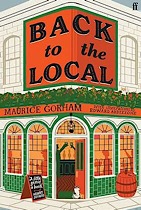 Back to the Local was first published in 1949 and Faber have now republished it (with its original illustrations by Edward Ardizzone) in a lovely new edition. Maurice Gorham writes as though for an audience of people who have never been in a pub before. At the time of its first publication, that must have been an odd choice as it’s clearly written for people who rarely go anywhere else but a pub. In 2024, it is a benefit because no-one reading it has been in a 1940s pub.
Back to the Local was first published in 1949 and Faber have now republished it (with its original illustrations by Edward Ardizzone) in a lovely new edition. Maurice Gorham writes as though for an audience of people who have never been in a pub before. At the time of its first publication, that must have been an odd choice as it’s clearly written for people who rarely go anywhere else but a pub. In 2024, it is a benefit because no-one reading it has been in a 1940s pub.
While a lot has changed in pubs over the last 75 years, Back to the Local touches on eternal truths. As Gorham points out, ‘Each one [pub] is somebody’s local’, and while he looks at pubs in central London, many of them have survived to the present day. The pubs surveyed are some of the most famous institutions in London: the French Housse, The Cheshire Cheese and the Prospect of Whitby are now as much tourist attractions as Buckingham Palace. While some things have changed, ‘he could go into a pub with a friend, order two drinks, put down a shilling, and get change.’ Yet Gorham’s social observations remain as accurate as ever: ‘the False Trade… when the smart people were discovering the pubs and the craze for darts even brought them swarming into the Public Bar.’ Modern day hipsters may have discovered IPA, rather than darts, but the sense of a pub being overrun by the young remains as vivid as ever.
Edward Ardizzone was the illustrator of many later editions of Dickens’ novels and his sketches brighten up the book, adding a touch of Dickensian gloom and giving the vivid impression that the people described here are English archetypes.
Gorham is devoted to his subject. He finds pleasure in everything about a good pub, from ‘the poetry of pub names’ to the range of pleasures available: ‘mild ale, bitter, Burton or Scotch ale, stout, strong ale or barley wine, and sometimes lager, cider, spirits, sherry and port.’ If some of the book is a snapshot of the past, such as the Jug-and-Bottle bar, where customers could buy beer to takeaway ‘to bridge that gap that lies between closing-time and reopening; particularly the long gaps that follow closing-time on Saturday and Sunday nights’, Gorham always finds a sentiment that connects the world of the 1940s with the present day. Gorham is the perfect companion to London’s pubs. He writes in the tone of a pleasant man giving directions to a stranger, friendly, informative and knowledgeable. He has firm opinions, ‘more than one pub has been closed to me by a juke-box’, but his enthusiasm is a pleasure to share.
Faber should be commended on the production of Back to the Local. They have given the book a flapped cover, which opens out into a map of central London showing the locations of those pubs described in the book which have survived, and which could be used as a reliable guide to London’s best pubs on its own.
Any Cop?: Back to the Local achieves the difficult task of capturing what London was like in 1949 while simultaneously evoking the atmosphere of a good pub in 2024.
James Doyle